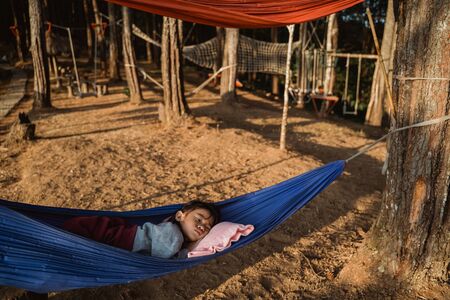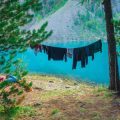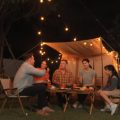1. Understanding Different Types of Tents
When it comes to planning a camping trip, one of the most important pieces of gear you’ll need is a tent. But with so many styles and sizes on the market, choosing the right one can feel overwhelming. Let’s break down the different types of tents available and help you figure out which one fits your camping style, group size, and destination.
Dome Tents
Dome tents are among the most popular choices for casual campers. They’re lightweight, easy to set up, and offer good wind resistance thanks to their curved shape. Dome tents typically have two poles that cross in the center and form a rounded top, which helps shed rain effectively.
Best For:
- Weekend camping trips
- Small groups or couples
- Mild to moderate weather conditions
Cabin Tents
Cabin tents are designed with near-vertical walls that maximize interior space—making them ideal for families or larger groups who want room to stand up and move around inside. These tents often come with multiple rooms or dividers for added privacy.
Best For:
- Family camping trips
- Longer stays at campgrounds
- Campers who prioritize comfort and space
Tunnel Tents
Tunnel tents use a series of flexible poles arranged in parallel arches to create a tunnel-like shape. They offer excellent space-to-weight ratio but may require more time to pitch and need to be securely staked down in windy conditions.
Best For:
- Backpacking with a small group
- Campsites with plenty of space for guy lines
- Calm weather or sheltered areas
Backpacking Tents
If you’re hitting the trail and carrying all your gear on your back, backpacking tents are the way to go. These tents are built with lightweight materials and compact designs to minimize bulk without sacrificing shelter from the elements.
Best For:
- Solo or duo backpackers
- Minimalist campers
- Hiking and trekking adventures
Pop-Up Tents
Pop-up tents are perfect for beginners or those who want a hassle-free setup. These tents literally “pop” into shape when you remove them from their bag, making them great for festivals or spontaneous weekend getaways.
Best For:
- First-time campers
- Short overnight stays
- Fair-weather conditions only
Tent Comparison Table
| Tent Type | Main Features | Ideal Group Size | Recommended Use |
|---|---|---|---|
| Dome Tent | Lightweight, easy setup, wind-resistant shape | 1–4 people | Casual camping in mild conditions |
| Cabin Tent | Tall walls, spacious interior, family-friendly layout | 4–10+ people | Family camping, extended stays at campsites |
| Tunnel Tent | Great space-to-weight ratio, needs staking for stability | 2–6 people | Sheltered sites, backpacking in groups |
| Backpacking Tent | Ultra-lightweight, compact, weatherproof design | 1–2 people | Trekking, hiking, solo adventures |
| Pop-Up Tent | Instant setup, minimal effort required | 1–3 people | Festivals, quick overnight trips in good weather |
Selecting the right tent really comes down to how you plan to camp. Consider your destination’s climate, how many people are coming along, and how much gear you’ll bring. With the right knowledge about tent types, you’ll be well on your way to creating an enjoyable outdoor experience.
2. Key Features to Consider
Choosing the right tent can make or break your camping experience. Whether youre heading out for a weekend in the woods or planning a week-long backcountry adventure, its important to focus on key features that match your needs. Let’s break down the essentials to help you pick a tent that’s just right for your trip.
Weather Resistance
When youre outdoors, weather can change quickly. A good tent should protect you from rain, wind, and even snow if needed. Look for tents with a high-quality rainfly, sealed seams, and a durable waterproof floor. For windy areas, choose tents with strong poles and low profiles for better stability.
Ventilation
No one wants to wake up in a damp tent from condensation. Proper airflow is key. Tents with mesh panels, multiple windows, and roof vents help keep fresh air flowing while keeping bugs out. This feature is especially important during summer camping trips or in humid climates.
Weight
If youre car camping, weight might not be a big deal. But if youre backpacking or hiking into your site, every pound counts. Ultralight tents are great for mobility but may compromise on space or durability. Think about how far you’ll be carrying your gear before deciding.
| Tent Type | Average Weight | Best For |
|---|---|---|
| Backpacking Tent | 2-5 lbs | Hiking & Long Treks |
| Car Camping Tent | 10-20 lbs+ | Drive-in Campgrounds |
| Family Tent | 15-30 lbs+ | Group & Family Trips |
Ease of Setup
If you’ve ever tried setting up a complicated tent in the dark or rain, you know why this matters. Some tents use color-coded poles or quick-clip systems to make setup faster and easier. Freestanding tents are also popular because they don’t require stakes to stand up—great for rocky or hard ground.
Materials
The fabric and poles of your tent affect its durability and performance. Common materials include:
| Material | Description |
|---|---|
| Nylon | Lightweight and common in backpacking tents; may need extra care to avoid rips. |
| Polyester | More UV-resistant than nylon; often used in car camping tents. |
| Canvas (Cotton) | Very breathable and durable but heavy; ideal for long-term setups or glamping. |
By focusing on these key features—weather resistance, ventilation, weight, ease of setup, and materials—you’ll be better equipped to find a tent that suits your specific camping style and environment.
![]()
3. Matching Your Tent to Your Camping Style
Choosing the right tent starts with understanding how and where you plan to camp. Whether youre car camping in a national park, backpacking the Appalachian Trail, or heading to a summer music festival, your camping style plays a big role in what kind of tent youll need. Lets break it down so you can find the perfect match.
Car Camping
If youre driving up to your campsite and parking nearby, weight and packed size aren’t huge concerns. That means you can prioritize comfort, space, and extra features.
What to Look For:
- Spacious Interior: Roomy tents with high ceilings let you move around easily.
- Multiple Doors & Vestibules: Great for families or groups.
- Extra Features: Built-in storage pockets, room dividers, or screened porches add convenience.
Backpacking
If youre hiking miles into the wilderness, every ounce matters. Your tent should be lightweight, compact, and easy to set up after a long day on the trail.
What to Look For:
- Lightweight Materials: Ultralight fabrics and poles reduce pack weight.
- Compact Size: Should fit easily in or on your backpack.
- Simplicity: Quick setup is key when youre tired or facing changing weather.
Festival Camping
Camping at music festivals is more about fun and convenience than braving the elements. Youll want something easy to use and comfortable for casual overnight stays.
What to Look For:
- Easy Setup: Pop-up tents or instant tents are ideal when you’re eager to hit the stages.
- Good Ventilation: Keeps things cool during hot summer nights.
- Style & Visibility: Bright colors or unique designs make your tent easier to find in a sea of others.
Tent Type Comparison by Camping Style
| Camping Style | Tent Type | Main Priorities |
|---|---|---|
| Car Camping | Dome or Cabin Tents | Comfort, space, weather protection |
| Backpacking | Ultralight Backpacking Tents | Weight, packability, quick setup |
| Festival Camping | Pop-Up or Instant Tents | Simplicity, ventilation, portability |
No matter your adventure—whether its a weekend getaway in Yosemite, a thru-hike on the Appalachian Trail, or dancing under the stars at Coachella—matching your tent to your camping style makes all the difference in comfort and ease.
4. Seasonal and Weather Considerations
When choosing a tent for your camping adventure, it’s important to think about the kind of weather you’ll be facing. Not all tents are built the same—some are made for sunny summer days, while others can handle heavy snow and strong winds. Picking the right one can make or break your trip.
Understanding Tent Season Ratings
Tents usually come with a season rating that tells you what kind of weather they’re designed for. Heres a quick breakdown:
| Season Rating | Best For | Weather Conditions |
|---|---|---|
| 1-Season | Backyard or Indoor Use | Very mild weather, no wind or rain |
| 2-Season | Late Spring to Early Fall | Light rain and mild temperatures |
| 3-Season | Spring, Summer, Fall | Rain, wind, and moderate cold |
| 4-Season | Winter Camping | Snow, high winds, and freezing temps |
| 5-Season (Expedition) | Extreme Mountaineering | Severe winter storms and sub-zero temps |
Match Your Tent to the Climate
Summer Camping:
If youre heading out in the middle of summer, ventilation is key. Look for a tent with lots of mesh panels to keep things cool and breezy. A lightweight 2- or 3-season tent will usually do the trick.
Fall or Spring Camping:
You’ll want something a little more durable since the weather can be unpredictable. A good 3-season tent should have strong poles, a full rainfly, and a waterproof floor to keep you dry during surprise showers.
Winter Camping:
This is where you need serious protection. A 4-season tent is built with stronger materials and fewer mesh openings to keep out snow and retain heat. It should also have steep walls to shed snow easily.
All-Year Use:
If youre planning trips in multiple seasons, go for a high-quality 3-season tent with optional add-ons like a footprint or extra rainfly coverage. It offers the most flexibility without being too specialized.
Packing for Unexpected Weather
No matter when youre going camping, its smart to prepare for unexpected changes in the weather. Always bring an extra tarp or groundsheet, check the forecast before you leave, and make sure your tent has sealed seams and good waterproofing.
Quick Tip:
If youre camping in humid areas like Florida or Louisiana during summer, look for tents with large mesh windows and roof vents to avoid condensation build-up inside your tent.
The right tent keeps you safe and comfortable no matter what Mother Nature throws your way. Take time to understand seasonal ratings and match them with your destinations climate so your adventure stays on track.
5. Tent Size and Capacity Tips
Picking the right tent size can make or break your camping trip. Whether youre going solo, heading out as a couple, or bringing the whole family (plus the dog), choosing a tent that fits everyone — and everything — comfortably is key.
How Tent Capacity Ratings Work
Tents are usually rated by how many people they can sleep — like 2-person, 4-person, 6-person tents, and so on. But heres the catch: those ratings assume a snug fit with little to no extra room for gear, pets, or personal space. If you want comfort, go one size up from what you think you need.
Recommended Tent Sizes Based on Group Type
| Group Type | Suggested Tent Size | Notes |
|---|---|---|
| Solo Camper | 2-Person Tent | Extra room for gear and stretching out |
| Couple | 3 to 4-Person Tent | Adds space for backpacks and maybe a pet |
| Family of 3–4 | 6-Person Tent | Room for sleeping bags, duffels, and kids’ stuff |
| Larger Family or Group (5+) | 8+ Person Tent or Multiple Tents | Bigger tents often have dividers for privacy |
Think Beyond Just People Count
- Packed Gear: You’ll need room inside the tent for backpacks, shoes, and other essentials — especially if it rains.
- Pets: Bringing your dog? Factor in extra floor space so everyone sleeps comfortably.
- Taller Campers: Look for tents with higher peak heights or longer floor dimensions if youre tall or just like more headroom.
Tent Layouts & Comfort Features
Larger tents often come with multiple rooms or built-in dividers — great for families who want a bit of privacy or separate sleeping areas. Some even include vestibules or screen rooms that provide sheltered space for gear storage or relaxing away from bugs.
A Quick Tip:
If youre car camping, its okay to go big since you dont have to worry about weight. For backpacking trips, though, choose lighter and more compact options without sacrificing too much comfort.
Selecting the right size tent ensures a better night’s sleep and a more enjoyable outdoor experience — no matter who you’re camping with.
6. Budget vs. Quality: Making the Right Investment
When youre shopping for a tent, its easy to get overwhelmed by the wide range of prices and brands out there. From $50 budget tents to high-end models costing over $500, the options are endless. But how do you know which one is right for your camping needs? The key is to find the sweet spot where cost meets long-term performance and durability.
Price Ranges and What to Expect
Heres a quick breakdown of common tent price ranges and what you can typically expect at each level:
| Price Range | What You Get | Best For |
|---|---|---|
| $50 – $100 | Basic materials, limited weather resistance, simple setup | Casual campers, backyard camping, occasional summer trips |
| $100 – $250 | Better materials, decent weather protection, more features like vents and vestibules | Weekend warriors, family camping trips, moderate conditions |
| $250 – $500+ | High-quality fabrics, strong poles, excellent weatherproofing, lightweight designs | Frequent campers, backpackers, all-season use |
Brand Reputation Matters
The brand of your tent can say a lot about its quality. Some well-known outdoor brands have built a solid reputation for producing durable and reliable gear. While you might pay more upfront for a trusted name like REI Co-op, Big Agnes, or MSR, youre also investing in better customer support, warranties, and proven performance in the field.
Top Tent Brands in the U.S.
- REI Co-op: Great balance of quality and affordability with excellent customer service.
- Big Agnes: Known for lightweight tents ideal for backpackers.
- MSR (Mountain Safety Research): High-performance tents designed for serious adventurers.
- Coleman: Budget-friendly options perfect for beginners or casual campers.
- NEMO Equipment: Innovative designs with comfort-focused features.
Finding Your Balance
If youre new to camping or only go once or twice a year, a mid-range tent around $150–$200 from a reputable brand could be your best bet. It offers enough durability without breaking the bank. But if youre planning multi-day hikes or camping in challenging weather conditions, investing in a high-end model will pay off in the long run by keeping you safe and comfortable.
Pro Tip:
Look out for seasonal sales (especially around Memorial Day or Black Friday) when top brands often offer steep discounts on their gear — its a great way to score quality at a lower price.
The bottom line: balancing your budget with quality ensures that your tent wont just last one trip but will become a reliable part of your outdoor adventures for years to come.


